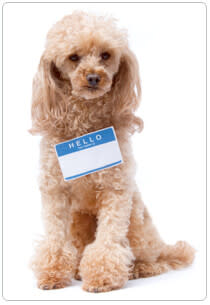
Your dog should be happy when he hears you say his name. His head should lift, his tail wag, and ideally, he should begin moving towards you. If he doesn’t come to you when you say his name, he should at least look at you and acknowledge you.
This doesn’t happen automatically, though. He didn’t come into the world knowing that his name was Sweetie. If you have a young puppy, his breeder probably called him something other than “black tri male puppy with a white tip on his tail.” So you need to teach him what his name will be in your household.
The same applies to an adopted dog. A dog my husband and I adopted several years ago had been in four homes, with four different names, before us. Because we wanted him to start fresh with us, with no emotional baggage that might be connected to any of his old names, we gave him a new name. That also meant we needed to teach him that name.
His Name is Always Positive
Your dog’s name should always be a bright happy light in his brain when he hears it. His name is not to be associated with housetraining accidents, playing too hard, or chewing on your shoes. Whether you've chosen a classic name or browsed through unique black dog names for your dark-coated pup, it's helpful that the name you pick is one you'll enjoy saying in a positive, upbeat tone.
If he thinks hearing his name means he’s done something wrong or that you’re angry with him, you have a problem. He won’t want to come to you (or otherwise cooperate with you) when you call him by name because he’ll be anticipating trouble. Never yell at him or scold him using his name. Yelling and scolding isn’t particularly effective dog training anyway, but using his name when you do is even less effective.
Teaching Name Recognition
When I brought my youngest puppy, Bones, home, I needed to change his name. His breeder had called him Jack and, although that was fine, I wanted to call him Bones.
I began by offering him particularly good treats as I said, “Bones!” in a happy tone of voice. Since he’s a food motivated puppy, that caught his attention. After a week or so of that, I also began saying, “Bones!” when I leaned down to pet him. I continued to use a happy tone of voice and, of course, I also smiled when petting him.
In addition, every time I saw Bones looking at me, I would acknowledge it with a happy, “Bones!” Not only does this continue his name recognition, but it makes me more interesting to a busy puppy who might decide to amuse himself in other ways. After all, carting the laundry from the dryer to the bedroom isn’t at all exciting to a puppy, but if I burst out with a happy, “Bones! Good puppers!” that might make me worth following and watching.
As I started his puppy training, I also maintained that sense of fun, both with the training and with his name. “Bones, sit,” is always accompanied by treats, petting and praise. The same applies to all his obedience exercises.
Don’t Stop
Bones is eight months old now and knows his name very well, but I continue to keep it positive. Walking in the back yard I may just say, “Hi, Bones!” and encourage him to run or bounce or have fun. I figure if I say his name and his eyes light up, his tail wags, and he makes eye contact with me, I’m doing it right.